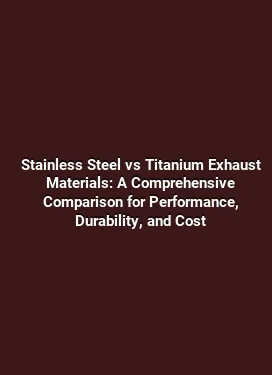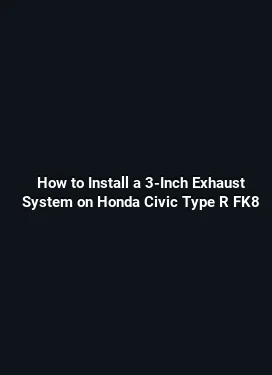How to Install Downpipe and High Flow Cat on BMW N55 Engine
Upgrading the exhaust path on the BMW N55 engine is a popular route for enthusiasts seeking improved exhaust flow, stronger mid-range torque, and a more aggressive intake and exhaust note. The combination of a dedicated downpipe and a high flow catalytic converter can unlock measurable performance gains when paired with quality fittings, gaskets, and a careful installation process. This guide provides a thorough, step-by-step approach that emphasizes practical tips, common pitfalls, and real-world considerations to ensure a reliable upgrade rather than a source of nuisance codes or leaks.
The N55 is known for its turbocharged setup and efficient exhaust routing. A well-designed downpipe reduces backpressure right after the turbo, while a high flow cat preserves catalytic efficiency while minimizing flow restrictions compared to factory units. When selecting components, it is important to consider materials (tubing diameter, stainless steel grade, and weld quality), sensor placement, heat management, and compatibility with the engine’s electronic control unit (ECU) strategy. The aim is a balanced system that behaves consistently across RPM ranges and under varying ambient conditions.
Downpipe and high flow cat fundamentals for the N55

The downpipe is the section that connects the turbocharger outlet to the rest of the exhaust, and it typically presents the most significant restriction in the stock setup. A high quality downpipe often features larger diameter tubing, a smoothly radiused bend geometry, and robust flanges that resist warping during heat cycles. A well-designed downpipe can reduce backpressure without inducing nocturnal exhaust drone that some drivers find objectionable at highway speeds. The high flow catalytic converter is designed to offer reduced flow restrictions relative to the OEM catalyst while still meeting emissions requirements in most regions. When both components are used together, the system can deliver a more linear torque curve and a deeper exhaust tone without sacrificing catalytic performance in daily driving.
Beyond performance, installation quality matters. A poorly fitted downpipe can lead to exhaust leaks, misalignment with the subframe, or interference with engine mounts and heat shields. A robust high flow cat should come with a heat shield or be paired with one to protect adjacent components and reduce under-hood heat soak. The N55’s sensor suite includes an upstream oxygen sensor (O2 sensor) and a downstream sensor that monitors catalytic activity. When upgrading, ensure sensor bungs align properly and that wiring harnesses reach the sensors without tension. Misfiring, check-engine lights, or a degraded air-fuel mixture can occur if sensors are stressed or if exhaust leaks occur upstream of the sensors.
Planning the upgrade: selecting parts and compatibility checks
Compatibility starts with the turbo outlet size and the downstream pipe routing. Many aftermarket downpipes use a 2.0 to 2.5-inch step or a consistent 2.5-inch diameter, often with a flex section to accommodate engine movement. The high flow cat typically uses a similar ID and a design that positions the catalyst closest to the exhaust manifold shield to maximize heat in a controlled manner. When selecting components, verify that the flanges match the factory flange bolts pattern and that the flange thickness does not introduce misalignment with the mid-pipe connection. In some kits, the downpipe includes a sensor spacer or extender for the upstream O2 sensor to ensure the ECU reads the correct signal after the change in flow characteristics.
It is also wise to review local regulations and inspection requirements. In many regions, an aftermarket catalytic converter must meet performance standards and be properly labeled. For streetside use, a high flow cat that maintains structural integrity, uses a durable substrate, and ensures reliable front-end emissions monitoring is essential. If uncertain, consult with an installer who has experience with N55 platforms, as the factory diagnostics expect certain flow values and sensor responses to maintain smooth operation.
Tools, hardware, and safety considerations

Key tools include a full set of metric sockets and wrenches, a torque wrench capable of precise settings (low and high ranges), penetrating oil, a rubber mallet, and assorted hand tools for reaching tight spaces under the car. A jack and jack stands or a hydraulic lift are essential for safe vehicle access. Don’t overlook safety equipment such as gloves, eye protection, and a magnetic pickup tool for fasteners that may roll away in the wheel well area. Appropriate anti-seize compound can help future removals, while threadlocker may be used on threaded fasteners that are exposed to high vibration. Be sure to disconnect the battery before performing any work to prevent accidental short circuits while handling sensors and harnesses.
Before starting, inspect the undercarriage for heat shields and inspect the downpipe routing for potential interference with the subframe, sway bar, or transmission crossmember. If a heat shield is deformed or loose, re-seat or replace it to prevent rattling or heat transfer to nearby components. Have replacement gaskets on hand for the turbo outlet and the downpipe connection to the mid-pipe to ensure a proper seal and avoid exhaust leaks that can trigger check engine lights or cause odor at the rear. It’s also helpful to have a spare set of O2 sensor gaskets and a bottle of brake-clean for cleaning mating surfaces prior to installation.
Step-by-step installation: from prep to final checks
Begin with a clean workspace and a vehicle that is cooled down. Remove necessary components such as the heat shield above the downpipe area to gain access to the turbo outlet and the factory downpipe clamp. This portion is often the most time-consuming step, requiring careful loosening of clamps and bolts without over-torquing cast components. A penetrating oil helps free stubborn fasteners, but avoid letting it spread to electrical connectors. When removing the stock downpipe, support the pipe to prevent accidental damage to the turbo or catalytic housing and prepare a clean surface for the new gasket.
Install the new downpipe by aligning the turbo outlet with the exhaust flange first, then gradually thread the bolts by hand to prevent cross-threading. Tighten the bolts in a crisscross pattern to ensure even clamping force. After securing the downpipe to the turbo, inspect the routing for clearance relative to the subframe and heat shields. Install the high flow cat in the same manner, paying careful attention to the direction of flow indicated by the manufacturer and ensuring that the sensor ports align with the O2 sensor harness locations. If the kit includes a sensor spacer, install it according to the provided guidance. Reconnect any sensors and harnesses with clean, unpinched connections and verify that there is no tension on the wiring when the suspension moves through its range of travel.
With the physical installation complete, perform a leak check by starting the engine briefly and listening for hissing or exhaust leaks around the flanges. A soap solution can help identify small leaks at joints. If a leak is detected, tighten the corresponding fasteners uniformly while the engine is off. Recheck after road testing for a short period under load to ensure nothing shifts during acceleration and deceleration. A brief drive with careful monitoring of the engine’s response and any check engine lights will help confirm that sensors are reading properly and the ECU is adapting to the new flow characteristics.
Refer to the torque specifications provided by the component manufacturer and adhere to recommended service intervals. After a successful initial test, monitor the system under various driving conditions—cold start, warm-up, and sustained cruising—to verify consistent operation. The goal is not only a louder exhaust, but a measurable improvement in response, especially in the lower and mid RPM ranges where turbo spool is most notable. If the vehicle exhibits turbo lag or a noticeable drop in low-end throttle response, a tune or ECU reflash from a trusted tuner can optimize fuel delivery and ignition timing to complement the increased flow, though this step is optional depending on local regulations and personal preferences.
Post-installation considerations: heat management and long-term care
Heat management remains a critical factor after any exhaust modification. The downpipe and high flow cat will channel more heat closer to the engine bay, which can affect nearby components if heat shields are inadequate. Consider upgrading or reinforcing heat shielding around the exhaust route and installing reflective heat blankets in areas prone to heat soak. Regular inspections should include looking for signs of heat-induced wear on lines, hoses, or electrical wiring near the exhaust path. Visually inspect the catalytic converter housing and the downpipe for signs of exhaust leaks or cracks after several miles of driving, especially around weld seams and flange interfaces.
Fuel and ignition strategies may evolve with the new hardware. While a basic installation can function without adjustments, some drivers opt for mild calibration tweaks to optimize fuel trim and boost response, particularly in models with variable valve lift or sophisticated turbo control. If a tune is pursued, select a reputable tuner with experience on the N55 platform to preserve reliability and ensure that the long-term health of the turbo and intercooler system remains intact. Document all changes and maintain records of any service performed for future maintenance or resale considerations.
Practical tips for a clean, reliable upgrade
- Choose a downpipe with a robust bend geometry and a durable flange to resist distortion during heat cycles. A rigid coupling and a stainless construction help reduce the chance of leaks. - Verify that all hardware is included and that hardware is sized to the correct thread pitch and length. Missing bolts or mis-sized gaskets are a common source of leaks and torque loss. - If the kit includes studs and nuts, replace factory fasteners where recommended to ensure a better seal and reduce the chance of cross-threading. - Consider keeping the OEM downpipe alternate if required for emissions testing. Some regions allow dual configurations, so it’s prudent to understand the local rules and its impact on warranty coverage. - Schedule a road test that includes passing acceleration and steady-state cruising to evaluate airflow, exhaust tone, and sensor feedback. Watch for unusual fuel trims or misfire codes that could indicate sensor or wiring concerns introduced during the upgrade.
From a performance perspective, a well-executed installation typically yields stronger throttle response, a more linear boost curve, and a sportier exhaust note without excessive cabin drone. The N55 engine responds well to improved exhaust routing, but the response is highly dependent on precise fitment, sensor compatibility, and how well the system integrates with the factory ECU's feedback loops. A thoughtful combination of hardware, careful installation, and post-install tuning (when appropriate) can transform the driving experience while maintaining reliability and daily drivability.






